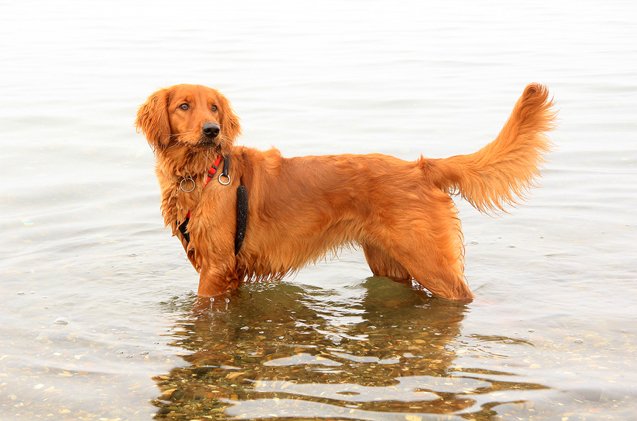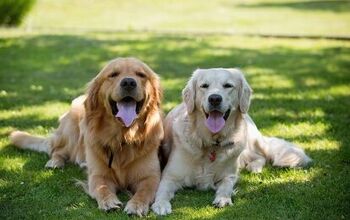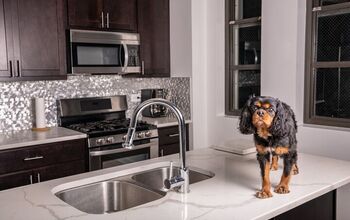Golden Irish


About Golden Irish
Golden Irish Basics
Sometimes, a combination of two dog breeds simply works like a charm. Like peanut butter and chocolate, the Golden Irish offers to great flavours that taste even better together. Combining the good looks and personalities of the Golden Retriever and the Irish Setter, the Golden Irish makes a wonderful family pet. They offer everything that a growing family could possibly want from their fur baby. These dogs will be thrilled to meet you, excitedly race to the door to see you at the end of every day, and they will remain lovingly loyal to the end. They enjoy getting and giving loads of attention and affection, and they are a lot of fun to be around. These pups make life a little sweeter just by being at your side.
Before diving in and bringing a Golden Irish home, though, check out the information below to learn more about this popular designer breed. While these dogs are indeed wonderful, they won’t be the right fit for every household. The only way to find out whether or not they will fit into your home is by doing the research. You’ve come to the right place for that. So keep your eyes glued to this page and scroll away. Everything that you could possibly want to know about owning a Golden Irish is about to be revealed.
The Golden Irish is a cross between a purebred Irish Setter and Golden Retriever.
Origin
The Golden Irish is a designer dog breed whose origins aren’t entirely clear, but the breed may have been developed in the 1980s as that is when designer dogs became more popular. Sadly, we don’t have any official information available about the origin of this breed. While there were undoubtedly puppies born from Golden Retriever and Irish Setter parents for many years “by accident,” breeders wouldn’t have started coveting this hybrid until some point during the designer dog boom of the 80s. Unfortunately no breeder ever claimed credit for being the first to sell and specialize in the Golden Irish, so unfortunately we can’t offer any more info about this remarkable dog’s origin than that. Even so, today the Golden Irish is a widespread and popular designer breed, loved by owners across the world. And there are plenty of reasons to cause such popularity.
Pedigree
The Golden Irish is a cross between a purebred Irish Setter and Golden Retriever. Which traits any Golden Irish will favour from their parents is entirely unpredictable. This is true of all hybrid breeds. Sometimes even puppies born from the same litter can vary wildly in terms of physical traits and temperament. While some owners enjoy the fact that this means their dog will be unique, others prefer more predictability in their pups. So that’s something to keep in mind if you value pooch predictability. Still, if the pedigree and the history of the breed are something important for you, you can simply study the hefty histories of the two parent breeds and learn all that there is to know about the provenance of the Golden Irish. After all, this unique crossbreed is the direct combination of the two – there is a bit of each in the Golden Irish.
Food / Diet
For any dog, no matter the breed, diet is everything. It is the cornerstone to good health, and will always have to be of the best quality. To help keep your Golden Irish in the best shape, choose a high quality dog food that contains whole food ingredients without any allergenic ingredients or artificial preservatives. If you hope to feed your pooch a homemade diet or a raw diet, talk to your vet to get some helpful pointers and to ensure your pet’s nutritional needs will be met. Remember it is never smart to experiment with diets on your own, or to feed your pet scraps and leftovers from the table. No vet would ever recommend that!
If you opt to feed your beloved companion a high quality dry food for dogs, a good range is anywhere from 2½ to 3 cups each day, but split this amount up into at least two servings. However, if you are also going to give your dog a high quality canned food, reduce the amount of dry food accordingly so he doesn’t end up overeating. Measuring your pet’s food will help prevent unwanted weight gain.
Regardless of which method of feeding you choose, it’s always worth checking in with your veterinarian before establishing or altering your dog’s diet. While pet food manufacturers and pet blogs provide useful feeding guidelines, they are still guidelines and should never be treated as gospel. All dogs are different after all, each with their own needs. The only person qualified to determine the specific dietary needs of your personal pooch is a vet. So always rely on that good doctor’s expertise before making any significant changes to what you pour into your pup’s food bowl.
When it comes to training your Golden Irish, you can expect that your dog will be easy to work with.
Training
For new and future dog owners, it is important to always stick to training. This is such an important aspect of proper dog upbringing, and it can’t be overlooked. With training, you are working to promote all the best traits in your pet, especially in those formative years when they are quite little. When it comes to training your Golden Irish, you can expect that your dog will be easy to work with, especially if you start when your companion is still a puppy. It’s so important to not waste those early and impressionable puppy days and start training as socialization as soon as possible. It’s so much easier to train good behavior early on than it is to correct problematic behaviour in an adult.
Overall, this is an intelligent breed, and the Golden Retriever genes will make your pet the type that will listen and obey. You may find that you need to use fewer repetitions during your training sessions until your pooch learns the ropes. However, if the Irish Setter genes are stronger, you might notice that your dog is a bit more of the independent type, so training might be a bit harder.
For the best results, stick with training sessions that are short and engaging. Using positive techniques that include motivating your pooch with rewards and treats is highly recommended. Though you want to be firm, you should never be harsh. Instead, be patient and consistent so your dog will learn the rules in no time. Remember, with plenty of patience and tasty treats, any result is achievable!
Weight
A large sized breed, the Golden Irish weighs between 55 and 80 pounds. Due to their weight and height, these dogs will require plenty of free space to roam around. This means that tiny and confined apartments just won’t do for this breed. They will thrive in a spacious home, preferably with a fenced-in yard. This would give them space to run around, play, and exercise as much as they want without any inconvenience to you. If you don’t have a yard, then you will need to provide regular walks in the park and around the block. Golden Irish dogs are active and energetic, and will need the exercise to remain lean, happy and strong.
Temperament / Behavior
If you’re in search of a wonderful family dog, the Golden Irish is a good choice. These are loyal canines and thoroughly enjoy meeting people and spending loads of time with their human family. They also like being the center of attention, playing, and interacting with kids. They are a breed with a versatile character, having something to offer to everyone.
You should expect that your Golden Irish will be filled with energy. These lively dogs enjoy being social and active, and they can be somewhat mischievous at times, but they are also trustworthy and even-tempered. As you can see, their character is very colorful, but filled with a lot of positivity and acceptable traits. It is hard to be displeased with a Golden Irish.
When it comes to living with other pets, the Golden Irish can get along well with other animals when he is socialized properly from a young age. Keep in mind that both the Irish Setter and the Golden Retriever have an instinct to hunt down prey, so your pet may be inclined to chase smaller pets. However, this can be easily remedied with some early training. If you see a tendency of your Golden Irish to chase other smaller dogs or pets, you’ll need to quickly make them know that it is not OK to do so. Use a commanding tone of voice, and – after the command is understood and obeyed – positive reinforcement. With a bit of treats and some patience, you can quickly train your pet.
Common Health Problems
Like all hybrid canine breeds, the Golden Irish might be prone to the health conditions that most commonly affect its parent breeds. However, there is no guarantee that your dog will inherit any of these problems, and mixed breeds tend to be surprisingly healthy and hardy. One of the best ways to ensure your puppy is healthy is to purchase him from a reputable breeder. Throughout your pet’s life, work with your vet and keep an eye out for symptoms.
Although there is no way to predict an individual dog’s long-term health, be aware of the symptoms that are associated with the following conditions, which are often seen in the Golden Retriever and Irish Setter: hip and elbow dysplasia, bloat, hypothyroidism, epilepsy, eye problems like progressive retinal atrophy, heart problems, cancer, obesity, Von Willebrand’s disease, allergies, hypertrophic osteodystrophy, canine atopic dermatitis, and osteochondritis dissecans.
Just keep in mind that if you neglect caring after your pet, these health issues can certainly appear. But if you stick to regular and high quality care, from food to grooming to exercise, then you can certainly count on sickness being a very slim possibility. After all, your pet will depend on your help in order to achieve that great health that they are known for. It’s also important to maintain regularly scheduled checkups with a vet (especially as your pooch ages into his senior years) to ensure that any potential health issues are identified and treated as early as possible.
Life Expectancy
The Golden Irish has an average lifespan of 10 to 15 years. Considering that the maximum life expectancy for most dog breeds is around 15 years, it’s easy to see that the Golden Irish has all the prerequisites for longevity! And, if we consider their kind disposition and friendly character, as well as their ability to bond with their owner, it’s clear as day why the Golden Irish is amongst the perfect candidates for a companion dog. Of course, in order for your pet to reach this max life expectancy, it is important that you take good care of them. Plenty of exercise, affection, and a balanced diet are the cornerstones of good dog health. Of course, regular visits to the vet are a must as well.
Exercise Requirements
The Golden Irish is an active breed, so you should take your dog out for a long walk at least once a day, if not twice a day. On top of that, your pet should be given some playtime at the dog park or in the backyard. And while he is spending time indoors, he should have a variety of toys that provide mental stimulation.
These dogs are best suited to living in a house with a yard. Your pet will prefer having more space, and a safe yard will allow him to run freely off-leash, as well as play some interactive games, such as fetch, with you.
Failing to give your dog the right amount of physical activity, mental stimulation, and exercise on a daily basis could cause him to become destructive. If a Golden Irish doesn’t burn off all of his excess energy in a day through exercise, he will find other more mischievous ways of burning off that energy. It’s important to keep these dogs well exercised every day so that they can continue to behave their best. Obviously, these pooches could also gain excess weight if they isn’t active enough. So, that’s another concern to keep in mind.
If you’re in search of a wonderful family dog, the Golden Irish is a good choice.
Recognized Clubs
The Golden Irish is not recognized by the American Kennel Club, as it is considered to be a hybrid breed. However, this breed is recognized by the American Canine Hybrid Club (ACHC), the Designer Breed Registry (DBR), the Designer Dogs Kennel Club (DDKC), the Dog Registry of America, Inc. (DRA), and the International Designer Canine Registry (IDCR). Considering that many hybrid breeds lack recognition, this is quite a good number of accepted registries. This means that you will be able to get in touch with other proud Golden Irish owners and share experiences, tips, tricks, and owner anecdotes.
Coat
A Golden Irish’s coat is silky, long, and luxurious, and this is a breed that is really defined by the beauty of its elegant coat. Still, the Golden Irish sheds a moderate amount. To keep its coat looking beautiful, you will need to brush it regularly, such as once daily. Of course, the shedding season might leave you with a bit of extra chores. In order to stop all that loose hair from ending on your furniture, you will need to brush more often. In the end, professional dog grooming salons are your best bet for long-haired dog breeds. Once a month visits will be ideal to keep your elegant Golden Irish looking spic and span.
Your best bet is to establish a grooming routine early on, and stick to it. Try to do some very light and quick brushing once per day, and some thorough grooming once per week or at least twice per month. This way you will always have your pet’s coat looking spic and span, and your work cut out for you. Leaving the coat unattended for days on end will only make grooming all the more difficult. In the end, if you find it too difficult to tackle, the professional grooming salon is always a good idea.
Puppies
Although the Golden Irish will grow up to be a large dog, puppies will be small and fragile, so take care to give your pet a safe space in which to learn and develop. As with all puppies, special care is mandatory. Avoid environments where there are a lot of children eager to play and cuddle with the cute puppies. This can harm the fragile pups and put them under a lot of stress. Wait a bit, and when they are out of their earliest, fragile puppy stage, they will be eager to go and play with anything and anyone!
To ensure your Golden Irish will get along well with children and other pets, start socializing and training him from as early on as possible. This will allow him to become comfortable around a variety of people and animals. A dog that has been neglected in the puppy stage and not socialized on time can develop a set of negative behavioral issues. These include fear, anxiety, aloofness, and aggression. While Golden Irish dogs are usually friendly and kind, they can still develop these traits. Excessive fear of new people and situations is one particular trait that can affect them. Of course, if you make sure they are introduced to other friendly dogs, children, and strangers at an early age, you will be actively working to develop a healthy and friendly adult dog.

Lisa Selvaggio is a freelance writer and editor, and our resident cats-pert, with certifications in pet nutrition and pet first aid. She enjoys producing content that helps people understand animals better so they can give their pets a safe and happy home.
More by Lisa Selvaggio
























